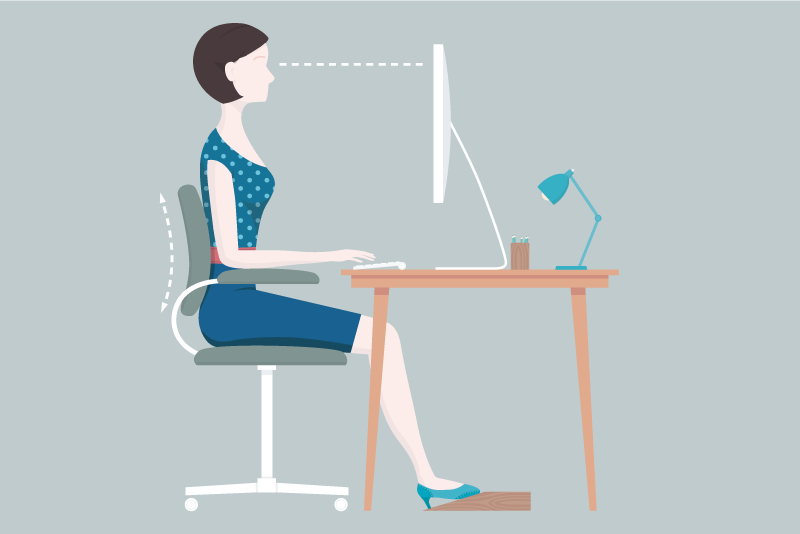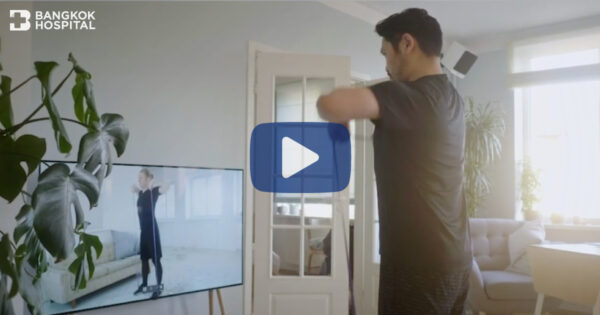Office Syndrome has been frequently found in office workers. It is not a disease, instead Office Syndrome is a group of symptoms caused by sitting or remaining in the same position for long periods of time, mainly while working with the computer in an office setting. Overtime, certain muscles become contracted, causing repetitive muscle strain. Main symptom related to the unhealthy sitting posture is muscle pain or tightness, especially in the neck, shoulders and back. Due to the restrictions in movement and activities during lockdowns, people have been currently instructed to work from home. Working at the office allows people to move, walk or change their positions during the day whereas working from home largely limits movement and activities. With increasing numbers of employees working at home, physical inactivity and prolonged sitting in the same position can lead to an increased risk of developing Office Syndrome.
Get to know Office Syndrome
Office Syndrome refers to a group of various symptoms including the inflammation of neck, shoulder and back muscles. These symptoms are caused due to repetitive muscle strain during having long period of unhealthy positions such as sitting in front of a computer screen for several hours. Posture and ability to function or move normally can be affected, leading to further health problems e.g. abdominal pain and stress. A wide variety of conditions of Office Syndrome may include:
- Myofascial pain syndrome: Myofascial pain syndrome refers to chronic pain disorder. In this condition, pressure on sensitive points in the muscles (trigger points) causes pain and compression in the affected muscle e.g. the neck, shoulders and shoulder blades.
- Carpal tunnel syndrome: Carpal tunnel syndrome causes pain, numbness and tingling in the hand, wrist and arm. This condition occurs when the median nerve, one of the major nerves to the hand is squeezed or compressed as it travels through the wrist.
- Trigger finger: Trigger finger causes pain, stiffness and a sensation of locking or catching when bending and straightening finger. The most often affected fingers are ring finger and thumb finger, but it can also occur in the other fingers.
- Tendinitis: Tendinitis is the inflammation of a tendon which is often affects the elbow, wrist, finger, thigh and other parts of the body.
- Postural back pain: Postural back pain is any pain or discomfort in the back area that is caused by poor posture.
- Patellofemoral syndrome: Patellofemoral syndrome is a broad term used to describe pain in the front of the knee and around the patella (kneecap).
- Dyspepsia: Dyspepsia or indigestion, is a term used to describe discomfort or pain in the upper abdomen. It refers to a group of symptoms that often include bloating, discomfort, nausea and burping.
Causes of Office Syndrome
Office Syndrome is caused by repetitive use of certain muscles during working with unhealthy posture. An inappropriate working environment is a major cause of Office Syndrome. Inadequate table height and positioning of the computer and keyboard lead to an unnatural sitting position. Slouching or hunching over with rounded shoulders causes constant muscle contraction, gradually resulting in weakness of core muscles and increased tension in other muscle groups. Other causes may involve excessive stress and insufficient sleep. In addition, physiological abnormalities e.g. muscle imbalance and spinal deformity might be the causes of Office Syndrome.

Prevention of Office Syndrome while working from home
Office Syndrome can be easily prevented by following these recommendations:
- Ergonomics and friendly working environment: The computer mouse and keyboard should be directly in front of you at a comfortable distance, with your arms properly supported. The computer screen should be an arm’s length away from you and level with or slightly below your line of sight. Appropriate lighting can reduce eye fatigue and headaches. Sitting next to the office window could increase your alertness and exposure to bright light also helps to raise productivity and regulate sleep. Proper posture should be maintained by sitting up straight with your shoulders rolled back, your chin tucked to elongate your spine and your thighs are parallel to the floor. Knee flexion should not exceed 90 degrees. If the feet cannot reach the floor, foot support can be used.

- Adjusting your sitting position regularly: Sitting position should be changed every 1-2 hours in order to prevent muscle fatigue and subsequent slouching. You can also change the angle of your seat and avoid sitting at the edge of the seat. During the day, it is also suggested to take short breaks to rest the eyes. This is also a good time to stretch or take a walking break.
- Regular exercise: To reduce repetitive muscle strain, it is important to have a regular exercise. Exercises that can stretch and strengthen core muscle groups as well as improve the posture is preferred.
- Avoiding all unhealthy behaviors: Excessive use of mobile phones and tablets must be avoided, especially before going to bed. Not only damaged eyesight, the continuous use of these gadgets can also result in additional strain around the neck, shoulders and shoulder blades.
- Taking sufficient rest: To remain healthy, adequate sleep, 7-9 hours per night on average should be maintained. Consuming the five food groups with proper portion in each meal and drinking enough water are also essential.
- Be active: All forms of physical activity play a major role in enhancing immune functions, resulting in lowered risks of being infected as well as quicker recovery if becoming infected. At-home workout routine can be started easily with a wide range of activities, for instance, house cleaning, gardening, dancing practice by using social network and playing games that physical movement is required.
Seeking medical assistance if chronic muscle pain persists
If muscle pain becomes a chronic problem that significantly disturbs daily life and activities, medical attention should be sought as soon as possible in order to receive accurate diagnosis and appropriate treatments. If serious complications develop, such as radiating numbness or tingling in the body possibly caused by herniated disc, severe joint pain especially at night and swelling mass, immediate medical assistance must be provided for further investigations.










